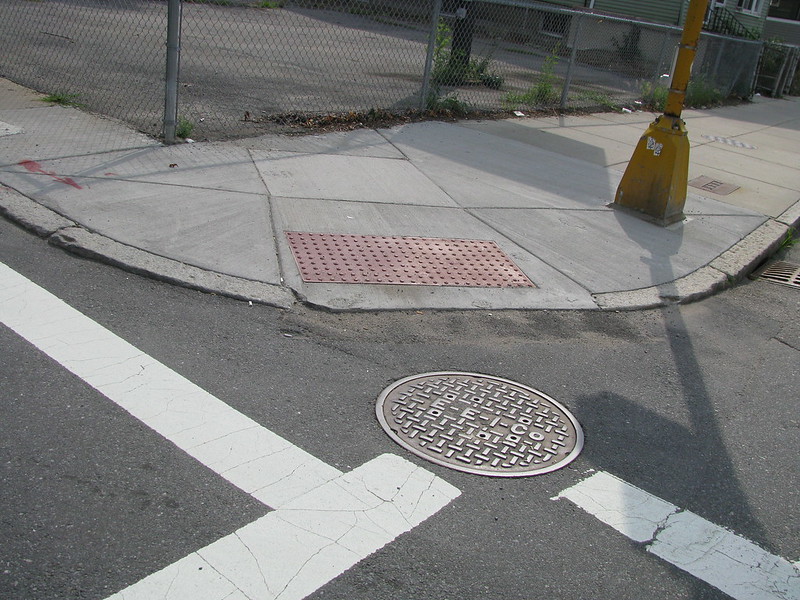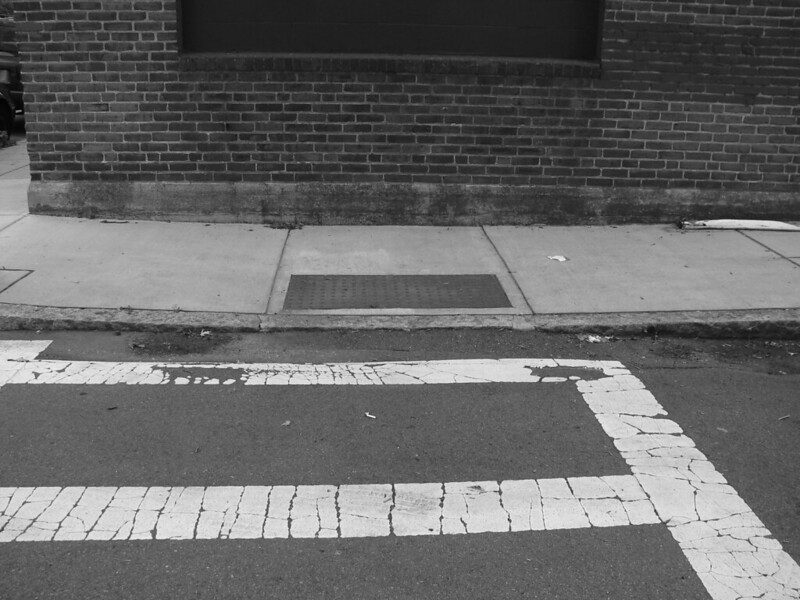So, with the ongoing battle between Beacon Hill and the world, I thought I'd start a discussion here.
Some background, courtesy of Universal Hub:
7/18 Battle over handicap accessibility on Beacon Hill continues to ramp up
7/22 You call this a world-class city? Walsh's treatment of Beacon Hill residents proves that a lie, she says
7/22 Naturally, the Beacon Hill Civic Association now considering suing the city over intersection ramps
First, my opinions.
I think Boston is being rather pig-headed in not doing what Cambridge has, using metal tactile pads. I think they look amazing, and match all the other street fixtures (storm grates, manhole covers, "drains into the charles" plaques, etc).
Also, I think Beacon Hill's incessant "WERE SO HISTORIC" argument is wearing thin, and is bullshit. Most historic photos of Beacon Hill show large granite slabs at corners, not brick. They were typically over storm drains. The point being, the whole argument that having a material other than brick at the corners just doesn't hold water. Having tactile strips framed by concrete would be in-kind with what was there. Additionally, bricks are a terrible material for paving. Period. Any argument that tries to say they are not is DOA. Yes, they may be preferable for aesthetic reasons, but that's doesn't preclude the fact that they are awful, even when laid carefully on a proper foundation (which Boston lacks).
An aside on the assery of Beacon Hill residents: I'm a preservationist. The awesome thing about it is solving the design issues inherent in being as respectful and contextual to the historic fabric as possible, while also accommodating the needs of modern society. One of the largest challenges in this is complying with ADA requirements. Frankly, I think Boston's solution, other than not considering the metal strips, is fine.
Lastly, I have trouble understanding the exact point of these tactile strips, particularly the color-contrast aspect of them. I will freely admit, I am an able-bodied not in any-way handicapped individual. Thatbeing said:
Wheelchair and impared mobility users are adequately accommodated by lowering the curb to street level. The tactile paving, to me at least, seems like an impediment to successfully navigating these intersections. Personally, riding my bike along a path that has them, they are a hazzard.
Visually impaired people seemingly benefit from them. The contrast identifies the intersection and the associated ramp. However, in every single example I have seen, the contrast between the tactile strip and sidewalk is nowhere near as stark as the contrast between the sidewalk and the street and crosswalk lines. It would seem that black asphalt next to white paint and light concrete/red brick highlights the intersection far better than a piece of plastic.
In the snow, they are impossible to shovel, and collect ice. Since it's cold here half the year, these tactile strips seemingly make walking less safe.
Blind people, to me at least, seem to benefit the most. Their cane makes a distinct sound when it contacts the strips. However, and I don't mean to sound as arrogant as I probably will, but haven't the blind been successfully been navigating street-sidewalk and back again for... ever?
My main point here is, how many people are actually benefiting from their installation? This is one of the issues I've had with ADA standards for quite some time. Complete compliance with them seems to place a very high monetary burden on the rest of the citizens, and in some cases also actually impedes enjoyment/usability of places. Redundant elevators, moveable wheelchair lifts that never_get_used, more expensive transit vehicles that perform worse, closure of parts of public buildings/spaces because they are not accessible, etc. At some point how much money, time, and resources is too much to accommodate a relatively small part of the population? Again, I'm really not trying to troll here or be insensitive, it is a legitimate concern for me.
I think sidewalk ramps are an unquestionable benefit to almost everyone. But are these strips in the same league to force the city to replace every_single_corner with a higher-maintenance system?
Anyway, I went out today and photgraphed three of Boston's choices for these strips. All laid in concrete, and amazingly all in a quarter mile radius of my house. First are the photographs themselves, then in greyscale (to simulate complete color blindness), and then blurred (to simulate impaired vision). Other than the blur/greyscale filter, I did not mess with any aspect of the photos.
Yellow:



Red:



Grey:



...discuss
Some background, courtesy of Universal Hub:
7/18 Battle over handicap accessibility on Beacon Hill continues to ramp up
7/22 You call this a world-class city? Walsh's treatment of Beacon Hill residents proves that a lie, she says
7/22 Naturally, the Beacon Hill Civic Association now considering suing the city over intersection ramps
First, my opinions.
I think Boston is being rather pig-headed in not doing what Cambridge has, using metal tactile pads. I think they look amazing, and match all the other street fixtures (storm grates, manhole covers, "drains into the charles" plaques, etc).
Also, I think Beacon Hill's incessant "WERE SO HISTORIC" argument is wearing thin, and is bullshit. Most historic photos of Beacon Hill show large granite slabs at corners, not brick. They were typically over storm drains. The point being, the whole argument that having a material other than brick at the corners just doesn't hold water. Having tactile strips framed by concrete would be in-kind with what was there. Additionally, bricks are a terrible material for paving. Period. Any argument that tries to say they are not is DOA. Yes, they may be preferable for aesthetic reasons, but that's doesn't preclude the fact that they are awful, even when laid carefully on a proper foundation (which Boston lacks).
An aside on the assery of Beacon Hill residents: I'm a preservationist. The awesome thing about it is solving the design issues inherent in being as respectful and contextual to the historic fabric as possible, while also accommodating the needs of modern society. One of the largest challenges in this is complying with ADA requirements. Frankly, I think Boston's solution, other than not considering the metal strips, is fine.
Lastly, I have trouble understanding the exact point of these tactile strips, particularly the color-contrast aspect of them. I will freely admit, I am an able-bodied not in any-way handicapped individual. Thatbeing said:
Wheelchair and impared mobility users are adequately accommodated by lowering the curb to street level. The tactile paving, to me at least, seems like an impediment to successfully navigating these intersections. Personally, riding my bike along a path that has them, they are a hazzard.
Visually impaired people seemingly benefit from them. The contrast identifies the intersection and the associated ramp. However, in every single example I have seen, the contrast between the tactile strip and sidewalk is nowhere near as stark as the contrast between the sidewalk and the street and crosswalk lines. It would seem that black asphalt next to white paint and light concrete/red brick highlights the intersection far better than a piece of plastic.
In the snow, they are impossible to shovel, and collect ice. Since it's cold here half the year, these tactile strips seemingly make walking less safe.
Blind people, to me at least, seem to benefit the most. Their cane makes a distinct sound when it contacts the strips. However, and I don't mean to sound as arrogant as I probably will, but haven't the blind been successfully been navigating street-sidewalk and back again for... ever?
My main point here is, how many people are actually benefiting from their installation? This is one of the issues I've had with ADA standards for quite some time. Complete compliance with them seems to place a very high monetary burden on the rest of the citizens, and in some cases also actually impedes enjoyment/usability of places. Redundant elevators, moveable wheelchair lifts that never_get_used, more expensive transit vehicles that perform worse, closure of parts of public buildings/spaces because they are not accessible, etc. At some point how much money, time, and resources is too much to accommodate a relatively small part of the population? Again, I'm really not trying to troll here or be insensitive, it is a legitimate concern for me.
I think sidewalk ramps are an unquestionable benefit to almost everyone. But are these strips in the same league to force the city to replace every_single_corner with a higher-maintenance system?
Anyway, I went out today and photgraphed three of Boston's choices for these strips. All laid in concrete, and amazingly all in a quarter mile radius of my house. First are the photographs themselves, then in greyscale (to simulate complete color blindness), and then blurred (to simulate impaired vision). Other than the blur/greyscale filter, I did not mess with any aspect of the photos.
Yellow:



Red:



Grey:



...discuss


